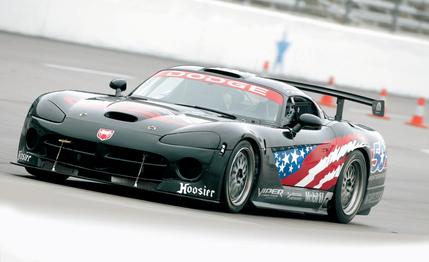
 Specialty File
Specialty File
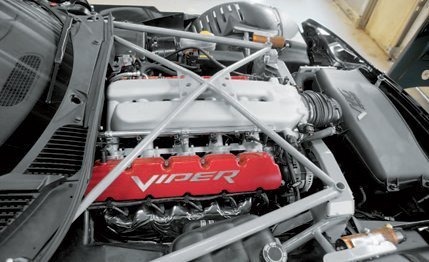



It's been about a year since we first slid our eager behind into Dodge's race-ready version of the Viper, which is called the Competition Coupe. During that first spin around the block, we weren't given license to strap on our test gear, but this time we flogged this racing snake thoroughly, and we're here to tell you exactly how ridiculously quick it is.
First, a little history. The Viper Competition Coupe is a 520-hp coupe version of the Viper SRT-10 roadster. It's not street-legal, and it's yours for $129,000, which is $44,205 steeper than a standard Viper. Since it went on sale last year, Dodge has sold 55 of them. It hopes to move about 25 a year.
According to John Fernandez, Dodge's head motorsports man, the plan was to create a profitable, self-sustaining racing program for these cars that is similar to Porsche's, which currently sells two racing versions of the 911—the 385-hp $135,627 GT3 Cup, and the 439-hp $345,569 RSR. These Porsche special editions of the 911 are popular racing cars—at this year's 24 Hours of Daytona, 25 of the 53 entries were 911s.


There were no entries bearing the Competition Coupe logo at that race because it's barred from racing in two of the three premier professional road-racing series—Grand American, which hosts the Daytona race, and American Le Mans. Both of these series have numerous racing classes that ideally each contain cars that are about equally fast. According to the officials we talked to, the Viper Competition Coupe is presently too fast for the slowest classes and not quite quick enough for the fastest. Dodge says it's willing to modify the car and is currently negotiating with those series' sanctioning bodies to determine exactly what changes need to be made.
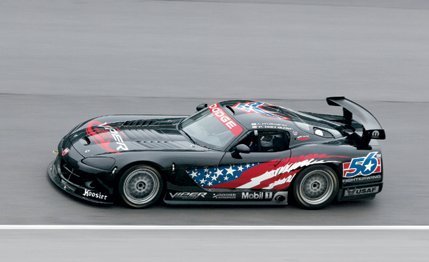

The Competition Coupe is legal for the third professional series—the SCCA Speed World Challenge—and last year it made an outstanding debut when Paul Mumford, a talented amateur driver, beat the factory Audi and BMW teams and their professional drivers at Mazda Raceway Laguna Seca and won in only his second World Challenge race. (Tragically, in October 2003, Mumford was killed in a plane crash.)
Those pro teams were, well, a little ticked off at the drubbing and cried that the car was an overdog. For 2004, the SCCA ordered that the Viper Competitions bear an additional weight penalty of 100 pounds (the one we tested weighed 3190 pounds), but Dodge still expects maybe a half-dozen teams to run its racing Vipers.
The car is also welcomed at Viper Club of America races, an amateur series for Viper enthusiasts. It was at the last Viper race of the season, at Texas Motor Speedway (TMS), where we got some seat time in the Competition Coupe.
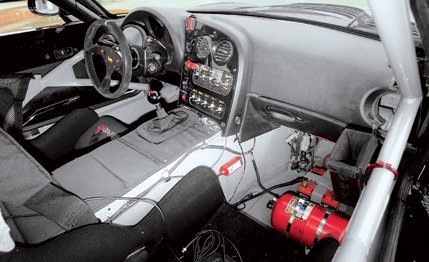

The Competition uses the street car's frame with an added jungle gym of steel bars that form a typical safety cage. The aluminum V-10 engine has been upgraded for racing duty with a higher-lift camshaft and the removal of the power-robbing catalytic converters. The transmission and the differential are stock, and coolers have been added to both to increase durability. Engineers retuned the suspension for stickier race tires. Racing safety gear has been added, including special seats, belts, window nets, and a fire-suppression system. There's also a new coupe body. That's what the sanctioning bodies prefer, and it helps the rear wing produce more downforce.
The Viper Competition is fantastically quick. Its monster 8.3-liter aluminum V-10 effortlessly yanks the car around, and it's so torquey (540 pound-feet at 4600 rpm) that it makes downshifting feel like an option. With help from the grippy 13.6-inch-wide Hoosier racing slicks, the Competition Coupe flashed to 60 mph in only 3.1 seconds, passed 100 in 7.0 seconds, and tripped the quarter-mile in 11.2 seconds at 130 mph.
Dodge figures the Competition is good for 193 mph, but we only got it to 160—which it achieved in 20.9 seconds, 1.4 seconds quicker than it takes a Nissan 350Z to hit 120 mph. The Dodge's anti-lock brakes (the rotors and the calipers are stock, but there are higher-temperature pads and brake ducts) hauled it down from 70 mph in only 134 feet (a Lamborghini Murciélago takes 155 feet), and it pulled 1.19 g on the skidpad (a Ferrari Enzo, 1.05 g).


Those kinds of numbers produce scary-fast speeds on a racetrack. TMS is a 1.5-mile oval with an infield road course that uses part of that oval. The road course exits onto the oval at the entrance to Turn Three. From there, the racing line proceeds through the 24-degree-banked Turns Three and Four. In the Competition, both those turns could be taken flat out; at the exit of Turn Four, our speed neared 150 mph.
Here's where we should remind you that the oval is lined with an immovable concrete wall. Now, the NASCAR guys might be used to flying next to the barrier, but for us, it took some major-league convincing to keep our right foot planted through the turns.
It wasn't that the car was hard to drive; it's just that, well, there's a wall. Lucky for us, we lined up behind Mike McCann, a Viper-club regular in his own Competition Coupe, for the qualifying session and did our best to stay on his bumper. The logic was simple: If he could do it, so could we.
That wasn't exactly true—he was faster, but he did help give us a much-needed recalibration. The Competition Coupe's performance envelope is just too far beyond that of the cars we ordinarily drive.
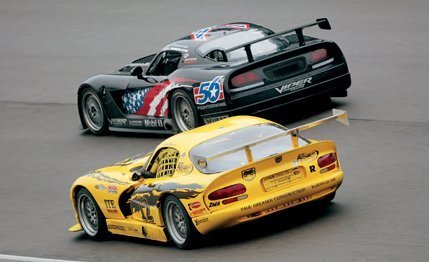

Dodge seems to have known that less-experienced drivers might buy the car and, consequently, tuned it for outstanding stability. The steering was light but offered excellent feedback. And the strong, fade-free anti-lock brakes proved to be reassuring retarders of triple-digit speeds.
The best part was the handling. Where some race cars get twitchy at their cornering limits, the Viper Competition never bobbled. Even when we did invoke some oversteer with a little too much throttle, we easily caught the first hints of the imminent spin. The coupe kind of floated around its cornering limits and gave us a chance to correct for mistakes. As high-performance race cars go, they don't get any easier to drive than this.
Hooking up with McCann was a good move, as we qualified second in the 17-car field. Just as the session ended, however, the skies opened up and didn't stop. Race officials didn't think a group of amateur Viper drivers on a wet track with concrete walls made for a prudent combination and canceled the race. That brought on an even bigger bummer: Our too-brief ride was over.
Viper Race Headquarters, P.O. Box 5054, Concord, North Carolina 28027; 888-960-3333; www.viper competitioncoupe.com.